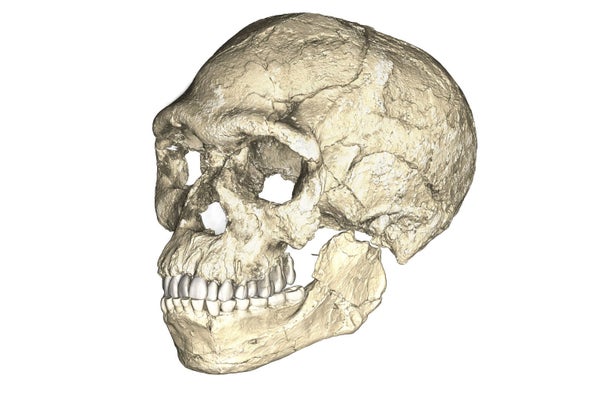The year was 1961. A barite mining operation at the Jebel Irhoud massif in Morocco, some 100 kilometers west of Marrakech, turned up a fossil human skull. Subsequent excavation uncovered more bones from other individuals, along with animal remains and stone tools. Originally thought to be 40,000-year-old Neandertals, the fossils were later reclassified as Homo sapiens—and eventually redated to roughly 160,000 years ago. Still, the Jebel Irhoud fossils remained something of a mystery because in some respects they looked more primitive than older H. sapiens fossils.

The reconstructed composite reveals a short, modern-looking face paired with a long, low braincase that calls to mind archaic humans. Credit: Philipp Gunz, MPI EVA Leipzig
Now new evidence is rewriting the Jebel Irhoud story again. A team led by Jean-Jacques Hublin of the Max Planck Institute for Evolutionary Anthropology in Leipzig, Germany, has recovered more human fossils and stone tools, along with compelling evidence that the site is far older than the revised estimate. The researchers described their findings recently in Nature. If the fossils do in fact represent H. sapiens, as the team argues, the finds push back the origin of our species by more than 100,000 years and challenge leading ideas about where and how our lineage evolved. But other scientists disagree over exactly what the new findings mean. Far from tidily solving the puzzle of our origins, the Jebel Irhoud discoveries add to mounting evidence that the dawning of our kind was a very complicated business.
On supporting science journalism
If you're enjoying this article, consider supporting our award-winning journalism by subscribing. By purchasing a subscription you are helping to ensure the future of impactful stories about the discoveries and ideas shaping our world today.
Experts have long agreed that H. sapiens got its start in Africa. Up to this point, the oldest commonly accepted traces of our species were 195,000-year-old remains from the site of Omo Kibish and 160,000-year-old fossils from Herto, both in Ethiopia. Yet DNA evidence and some enigmatic fossils hinted that our species might have deeper roots.
In their recent work, Hublin and his colleagues unearthed fossils of several other individuals from a part of the Jebel Irhoud site that the miners left undisturbed. The team's finds include skull and lower jaw bones, as well as stone tools and the remains of animals the humans hunted. Multiple techniques date the rock layer containing the fossils and artifacts to between 350,000 and 280,000 years ago.

Lower jawbone from Jebel Irhoud is nearly complete. Human fossils from this time period in Africa are exceedingly rare. Credit: Jean-Jacques Hublin, Leipzig
The researchers found that the sizes and shapes of the Jebel Irhoud face, lower jaw and teeth align with those of H. sapiens, not Neandertals or other archaic humans. But the braincase is elongated like that of archaic humans, not rounded like that of their modern counterparts. Such variations are associated with differences in brain organization. The team concluded that the Jebel Irhoud remains represent “the very root of our species, the oldest H. sapiens ever found in Africa or elsewhere,” Hublin said at a press conference. The remains reveal a group that lacked some of our hallmark traits but whose anatomical form could have gradually evolved into our modern one, he and his colleagues report in their paper describing the fossils.
Hublin noted that the findings do not imply that Morocco was the cradle of modern humankind. Instead, taken together with other fossil discoveries, they suggest that the emergence of H. sapiens was a pan-African affair. By 300,000 years ago early H. sapiens had spread across the continent. This dispersal was helped by the fact that Africa was quite different back then—the Sahara was green, not the forbidding desert barrier that it is today.
Not all scientists accept the premise that the Jebel Irhoud fossils belong to H. sapiens, however. Paleoanthropologist John Hawks of the University of Wisconsin–Madison notes that Hublin and his colleagues did not compare the Jebel Irhoud remains with 800,000-year-old fossils found in Spain from a species called Homo antecessor: “Maybe Jebel Irhoud was evolving into modern humans, but another possibility is that it is retaining facial morphology from an H. antecessor–like population that may have been the last common ancestor of Neandertals and later African archaic humans.”

Stone tools from Jebel Irhoud show people in North Africa had so-called Middle Stone Age technology by 300,000 years ago. Credit: Mohammed Kamal, MPI EVA Leipzig
The new fossils “raise major questions about what features define our species,” observes paleoanthropologist Marta Mirazón Lahr of the University of Cambridge. “[Is] it the globular skull, with its implications [for] brain reorganization, that makes a fossil H. sapiens? If so, the Irhoud population [represents] our close cousins” rather than members of our species. But if, on the other hand, a small face and the shape of the lower jaw are the key traits, then the Jebel Irhoud remains could be from our actual ancestors—and thus shift the focus of scientists who study modern human origins from sub-Saharan Africa to the Mediterranean—Mirazón Lahr says.
Either way, the discoveries could fan debate over who invented the artifacts of Africa's Middle Stone Age cultural period, which spanned the time between roughly 300,000 and 40,000 years ago. If H. sapiens was around 300,000 years ago, it could be a contender. But other human species were on the scene back then, too, including Homo heidelbergensis and Homo naledi.
The Jebel Irhoud finds “make the picture nicely complicated,” says archaeologist Christian Tryon of Harvard University. But the added wrinkle means that the scientists chasing the origins of our own species have their work cut out for them. Sometimes the most familiar things are also the most mysterious.
